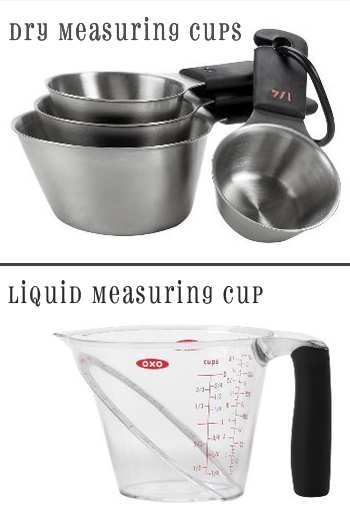As a food blogger, I try to provide my readers with great recipes that have been tested thoroughly in my kitchen. However, sometimes a recipe that worked well for me turns out a little less than perfect for a reader.
I am always willing to help my readers figure out what may have caused a variance in the texture, flavor, yield, color, etc. because as a baker, I learn from your experiences as well as my own. Typically the first question I ask is, “How did you measure the flour?”
I always thought dipping the measuring cup directly into the flour sack was an accurate means of measurement. However, when I started to teach myself how to bake – I realized this method can be pretty inaccurate.
Flour measurements can be one of the biggest variables when it comes to the finished product. Weighing ingredients is by far the most accurate, but not a common practice here in the U.S. If you’re an Alton Brown fan – like I am – you know from Good Eats, that this is pretty much the only way he measures dry ingredients.
A digital scale can come in pretty handy and is useful for more than just measuring your sugar and flour – I use mine a lot to weigh small packages for click and ship labels via USPS, they are also great for figuring out correct portions of meat and other items if you happen to watching your waistline.
If you don’t own a scale, when it comes to dry ingredients, you’re more than likely using a measuring cup. Many people use them with perfect results. But be aware that they can be incredibly inaccurate depending upon the method of adding the ingredient to the cup that you use.
Although I grew up using both liquid and dry measuring cups, I’ve come to realize through blogging that a lot of people don’t own both types of cups and some don’t know that two types of measuring cups exist. So, let’s start with the basics – if you’re going to bake, I strongly recommend picking up a set of dry measuring measuring cups as well as at least one liquid measuring cup. Both can be found in pretty much any store including places like Target, Amazon, the grocery store and even the dollar store.
I decided to conduct a little kitchen experiment and measure a cup of all-purpose flour two ways.
Here were the results:
1. Scooping a measuring cup into the flour and leveling: 6 oz in weight
2. Spooning the flour into a measuring cup and leveling: 4.25 oz in weight
2. Spooning the flour into a measuring cup and leveling: 4.25 oz in weight
Pretty big difference, right? Especially when it comes to baking. Because just a couple extra ounces of flour can really change the texture of a baked good.
The important thing to remember is that, much like brown sugar, flour packs. Scooping the ingredient with your measuring instrument will cause packing. Packing flour can add up quickly.
If you have a recipe with 3 cups of flour, and you scoop using your measuring up, you’d end up with 18 oz of flour, when in reality you should have 12.75 oz of flour. That’s nearly an extra 3/4 cup of flour in your recipe! That can dramatically change the results you get from a finished baked good.
Now, I know that not everyone has a scale – that’s okay because I am going to explain how to get a pretty accurate measurement without the use of a scale.
How To Measure Flour
1. Use a spoon to fluff up the flour within the container.
2. Use a spoon to scoop the flour into the measuring cup.
3. Use a knife or other straight edged utensil to level the flour across the measuring cup. King Arthur Flour has a plastic straight edge that I keep in my flour bin at all times for just this purpose.Here is a handy list of some of the commonly used weight measurements in my kitchen. All measurements are in weight ounces, not fluid ounces.Flours
all-purpose flour 1 cup weighs 4.25 ounces
cake flour 1 cup weighs 4 ounces
bread flour 1 cup weighs 4.25 ouncesSugars
granulated white sugar 1 cup weighs 7 ounces
confectioners’ sugar (powdered sugar); unsifted 1 cup weighs 4 ounces
light or dark brown sugar; packed 1 cup weighs 7.5 ouncesButter
butter 1 cup weighs 8 ounces
I also definitely recommend printing out a copy of this Master Weight Chart from King Arthur Flour. I laminated mine because I am kind of a messy baker. The list hangs from the side of my fridge, and I can honestly say it is one of my most used kitchen resources. And if you’re a visual person – like me, take a few seconds to watch this video from King Arthur Flour.












